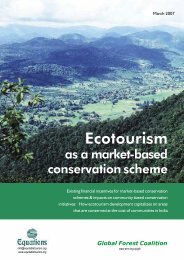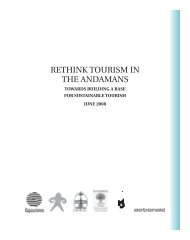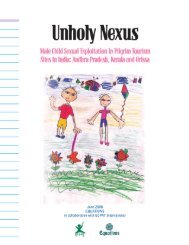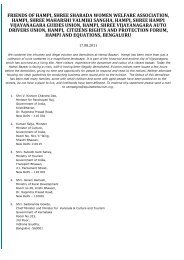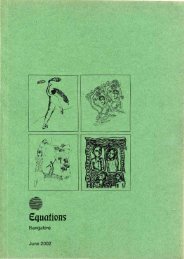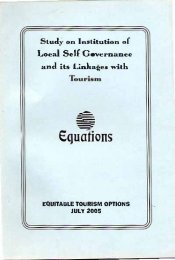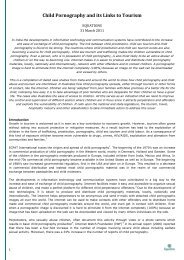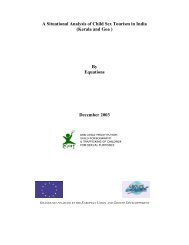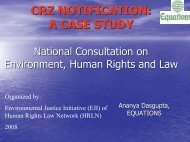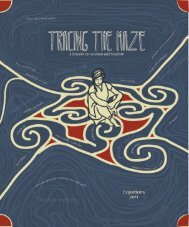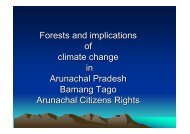Nilgiris Biosphere Reserve - Equitable Tourism Options
Nilgiris Biosphere Reserve - Equitable Tourism Options
Nilgiris Biosphere Reserve - Equitable Tourism Options
You also want an ePaper? Increase the reach of your titles
YUMPU automatically turns print PDFs into web optimized ePapers that Google loves.
1955. The Government of Karnataka declared Nagar Hole (which meant,<br />
Snake River, in the local language) as a game sanctuary in 1972.<br />
Subsequently the area under the sanctuary was further increased to<br />
64,339 ha. The NagarHole National Park was constituted in 1983.<br />
Over 9,000 indigenous people were residing in 58 hamlets inside what the<br />
government called the National Park. There were Jenu Kurubas, the<br />
honey-gatherers; the Hakki Pikki (bird-trappers), the Betta Kurubas who<br />
specialised in making bamboo baskets and utensils; the Yeravas who<br />
survived on fishing and the Soligas who had diversified into agriculture and<br />
herding goats. Apart from those who lived within the forests, there were<br />
more than 23,000 adivasis residing within 5 km distance, all depending on<br />
the Nagar Hole forests for their survival.<br />
Under the UN scheme for the <strong>Biosphere</strong> <strong>Reserve</strong>, the forests, the animals,<br />
the birds, the agriculture and the human being ought to have been<br />
protected for their uniqueness. But the government agencies continued to<br />
violate this norm for lucrative business interests. The natural forests were<br />
extensively logged and substituted with plantations of teak, eucalyptus and<br />
rosewood. Nearly 15 per cent of the area within the National Park is now<br />
under plantations.<br />
Evictions: Governments have been systematically pushing out the adivasis<br />
to the forest fringes. In 1970s, a total of 1220 families consisting of more<br />
than 6000 people were pushed out to locations 1-12 km from their original<br />
habitats. In more than 40 hamlets within the Park, adivasi lands were taken<br />
overforteak and eucalyptus plantations. People in 20 hamlets were ousted<br />
to make way for the Kabini River valley project and the Taraka dam. Those<br />
who were evicted and 'rehabilitated' did not get anything other than<br />
makeshift tents or huts to live in. They became 'coolies', menial servants, or<br />
virtual bonded labourers in estates.<br />
Severe restrictions were placed on indigenous people who continued to<br />
live within the forests. They were seen and labelled as encroachers.<br />
Trenches were dug in their fields and paths. No cultivation of any kind was<br />
allowed. This was so, despite the fact that the adivasi method of cultivation<br />
did not clear any trees, now ploughing or sowing was done, no chemical<br />
fertilisers or pesticides used. Hunting, even ritual hunting, was banned No<br />
livestock or dogs were allowed. No wells could be dug. The houses could<br />
Nikgiris : Fading Glory 72



